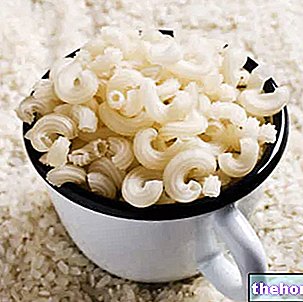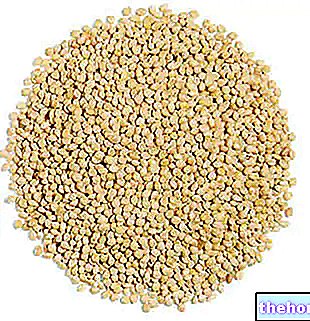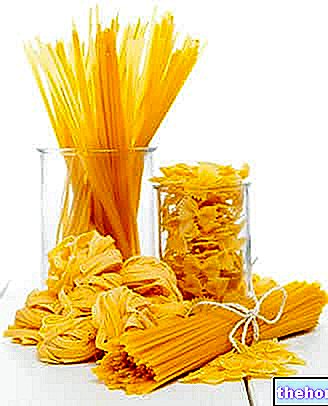See also: starch - rice starch - corn starch - wheat starch - potato starch
What is that
Rice starch differs from other types of starch for the contained volume of its granules (5/6 μm in diameter), which when observed under the microscopic appear polyhedral, isolated or variously joined together to form oval or rounded groups.

If added to the bath water, rice starch is also an excellent skin soothing and softener for children, certainly preferable to more aggressive soaps.
Production
Rice starch is obtained from the grains of the homonymous plant (Oryza sativa), which contain about 85% starch. The kernels are then immersed in a sodium hydrate solution, so that the caustic soda disintegrates the grain; the material obtained is then ground and reduced to a diluted suspension, which is skimmed ; following cycles of sieving (to eliminate cellulose), further washing, sedimentation and centrifugation.
Once purified and dried, rice starch appears as a white, very fine, tasteless powder that crunches under finger pressure and is practically insoluble in cold water and alcohol.
Ownership and uses
Like all types of starch, rice is also made up of two glucose polymers, one linear, called amylose, and one branched, called amylopectin. The latter, precisely by virtue of the branched structure, is of better digestibility, because it is easily attacked by digestive enzymes, to which it exposes a greater specific surface.
Amylose, in addition to being less digestible, does not gelatinize during cooking; consequently, grains containing starch rich in amylose tend to remain well separated during cooking. This is the case of long grain rice, also called fine or superfino, which, moreover, does not overcook, because amylose keeps cooking very well by stiffening, and has a low glycemic index, given its lower digestibility.
Varieties rich in amylopectin, such as small and round rice, appear sticky; therefore grains containing rice starch rich in amylopectin are particularly suitable for soups and desserts, as they tend to release starch during cooking.
Other Cereals and Derivatives Amaranth Wheat starch Corn starch Rice starch Modified starch Oat starch Bulgur Whole grains Corn Flakes Crackers Oat bran Bran Cus cus Amaranth flour Oat flour Buratto flour Spelled flour Buckwheat flour Corn flour Corn flour Millet Barley flour Quinoa flour Small spelled flour (Enkir) Rice flour Rye flour Sorghum flour Flour and semolina Whole wheat flour Manitoba flour Pizza flour Spelled Rusks Focaccia Nuts Wheat or wheat Wheat germ Burnt wheat Buckwheat Breadsticks Oat milk Rice milk Corn Maizena Malt Millet Muesli Barley Stale bread Unleavened bread and Pita Bread Carasau bread Egg pasta Rice pasta Wholemeal pasta Piadina Small spelled Pizza Pop corn Baked goods Quinoa Rice Basmati rice Converted rice White rice Rice Wholemeal Parboiled Rice Puffed Rice Venus Rice Rye and Horned Rye Semolina Semolina Sorghum Spaghetti Spelled Teff Tigelle Triticale OTHER ARTICLES CEREALS AND DERIVATIVES Categories Food Alcoholics Meat Cereals and derivatives Sweeteners Sweets Offal Fruit Dried fruit Milk and derivatives Legumes Oils and fats Fish and fishery products Salami Spices Vegetables Health recipes Appetizers Bread, Pizza and Brioche First courses Second courses Vegetables and Salads Sweets and Desserts Ice creams and sorbets Syrups, liqueurs and grappas Basic Preparations ---- In the Kitchen with Leftovers Carnival Recipes Christmas Recipes Dietary Recipes Light Recipes Woman's Day, Mother's Day, Dad's Day Functional Recipes International Recipes Easter Recipes Recipes for Celiacs Recipes for Diabetics Holiday Recipes Valentine's Day Recipes Vegetarian Recipes Protein Recipes Regional Recipes Vegan Recipes
















.jpg)











